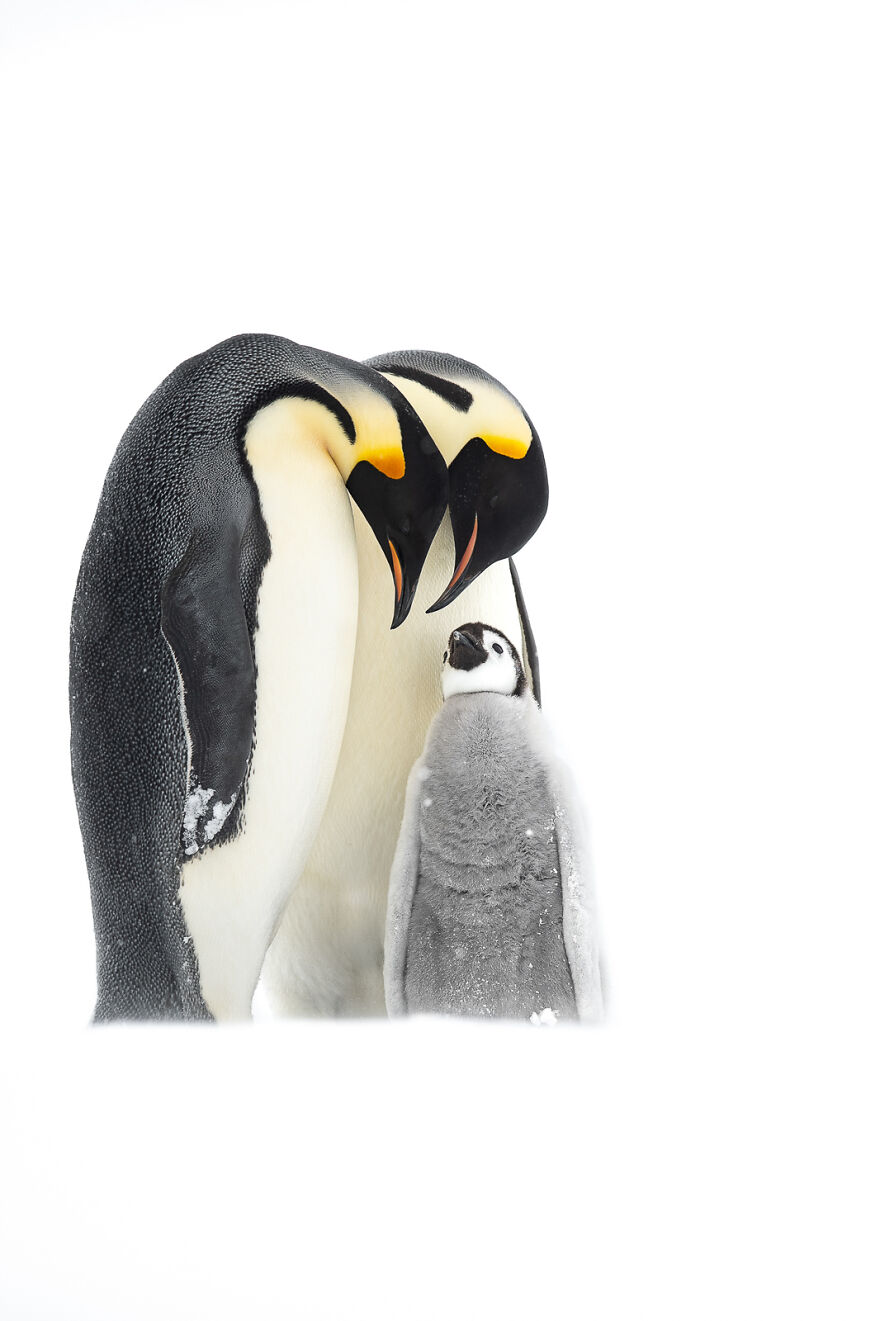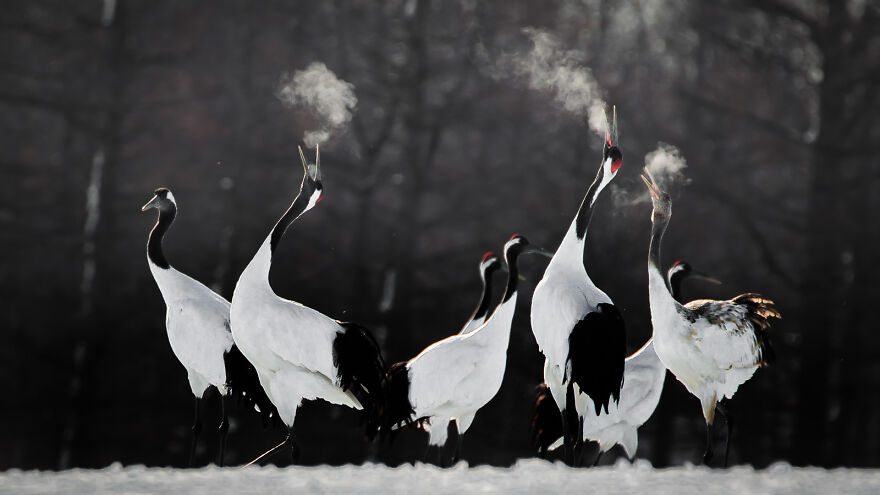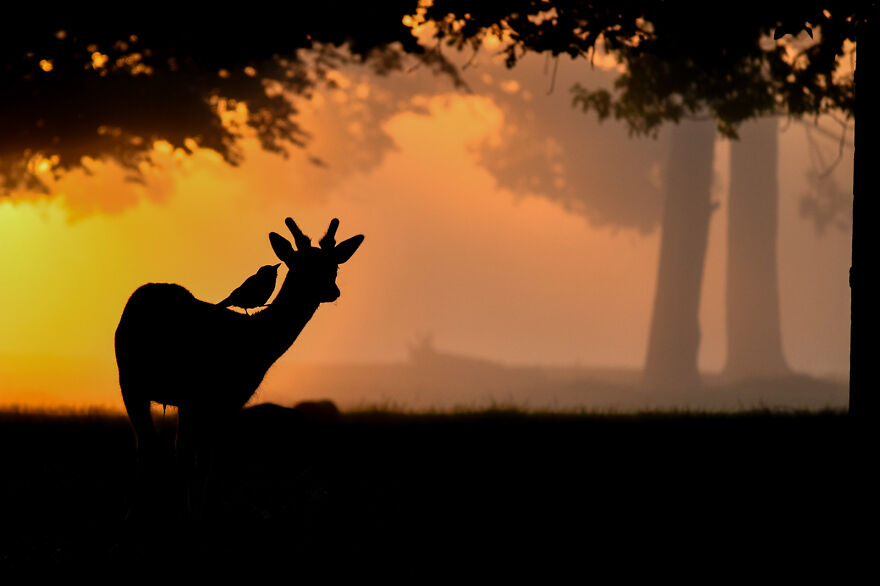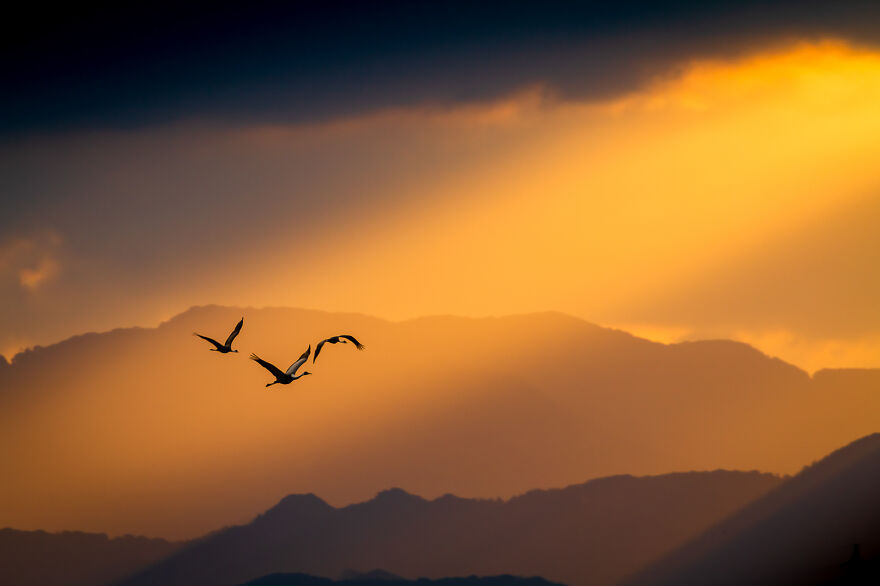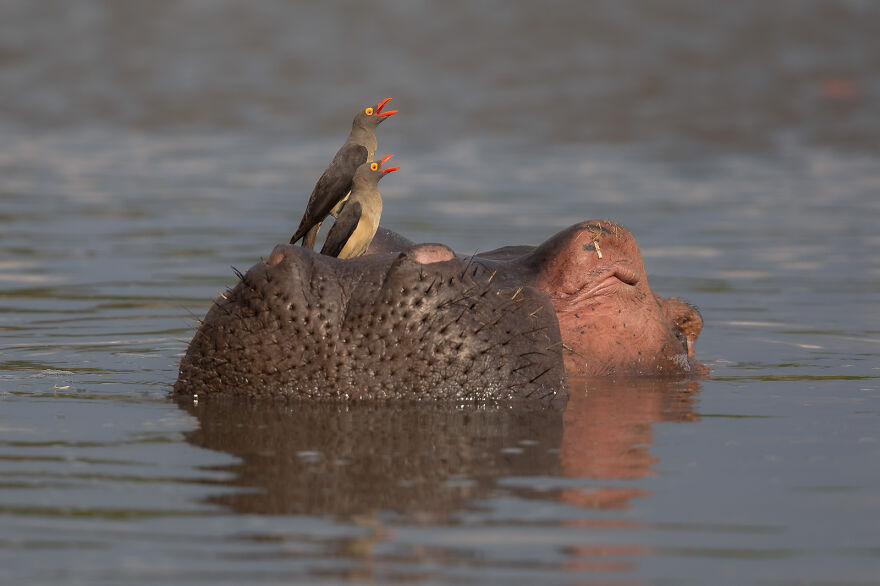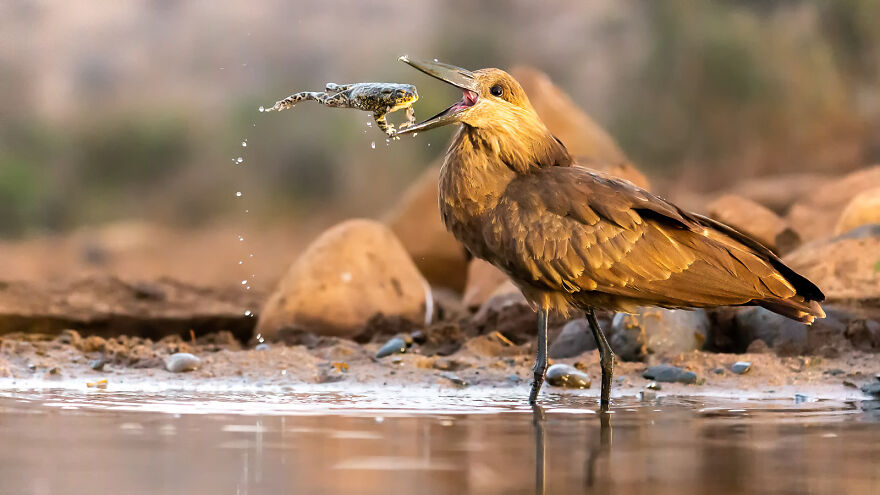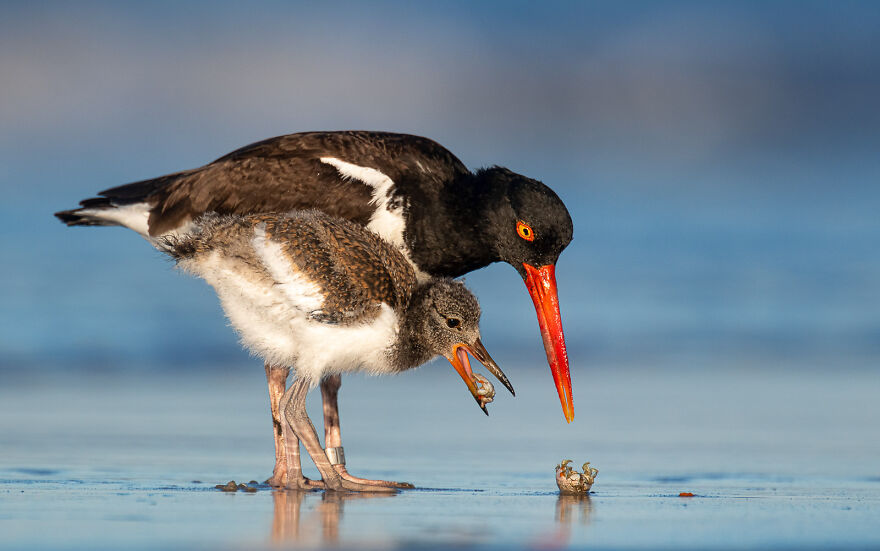Everyone that's been into photography knows that bird photos are probably the hardest to capture. It's one thing to just take a shot, but another to make an excellent photo. The photographers take countless hours to set up their shots, sneak and crawl in complete stealth and wait patiently for days on end with their extremely expensive gear. So it's no surprise that people that dedicate their time to avian photography should get the credit they deserve.
The Bird Photographer Of The Year Awards are the one of the most prestigious awards of avian photography. They have selected 31 finalists for their competition from over 20,000 entries. It's safe to say that these finalists are the cream of the crop of 2021 bird photography. So, without further ado, let's see what beautiful moments and views they've managed to capture.
More info: birdpoty.com | Instagram | Facebook | twitter.com
This post may include affiliate links.
Mallard Duck By Zdeněk Jak
I took the photograph on a pond in a beautiful park in a quiet part of the city of Prague. As a family of mallard ducklings swam past me, one of them began to chase a flying fly. It highlighted the fact that the instinct to feed is a powerful force even in the young, but of course the behaviour itself was comical from a human perspective. Regardless of how you view what’s going on, it certainly makes for an interesting photograph and a moment in time in a duckling’s life captured for posterity.
Mute Swan By Andy Parkinson
Over the years, I have developed a bond of trust with a group of mute swans and on this occasion, it paid dividends. This trusting relationship allowed me to capture this most intimate perspective: an infant cygnet resting its head peacefully on its sleeping mother. The female swan trusted me implicitly to stand this close and my accepted presence caused her not the slightest concern.
White-Tailed Sea-Eagle By Fahad Alenezi
In winter, food for most animals is in short supply in northern latitudes and many species, including this red fox, take greater risks than they would normally do to survive. In this photo, a particularly bold fox has ventured close to an area where eagles were feeding. One white-tailed sea eagle took exception to the incursion and gave the fox what looks like a good slap with its wings. That’s an encounter I imagine the fox will never forget.
Amazing picture! Interesting fact: the tail-feathers of these eagles are like fingerprints. After they are fully grown, the spattering will be in the exact same pattern after each molt. Where I live, there was once one of the white-tailed eagles stolen from a zoo and found later in a taxidermy-shop (I still get angry when I think about it!) The zoo was able to prove that it was that animal because they always keep the feathers after each molt and they had the full pattern of the tail as reference. Taxidermist went to prison not just for stuffing a highly endangered animal under the CITES-laws but also for theft and ... I don't know, if I had a say about it, I'd have wanted him to sit for murder, too!
Fiery-Throated Hummingbird By Gail Bisson
We stopped for lunch at a lodge in Costa Rica, one whose restaurant had multiple hummingbird feeders located throughout the property. The feeders, which are filled with sugary water, attract more than just hummingbirds and are also a magnet for insects. On this particular occasion, a fiery-throated hummingbird was resting on a perch a few feet away from the feeders when a wasp approached and landed on him. Disconcerted by the interest shown by the insect, the brief encounter generated a lot of chattering from the fiery-throated hummingbird, but eventually, both flew off unharmed.
Magnificent--hmmmmm- should have at least been No. 2... excellent scene set up, colorization collaboration, pictured scenery by nature, tells a heart warming story, hours and hours of concentration waiting for that one shot, PRICELESS.. my opinion, of course...
Emperor Penguins By Thomas Vijayan
The emperor penguin is the tallest and heaviest of its kind and is endemic to Antarctica. These flightless birds breed in the winter and, after a courtship lasting several weeks, the female lays a single egg, then leaves! Each penguin egg's father balances it on his feet and covers it with his brood pouch, a very warm layer of feathered skin designed to keep the egg cozy. There the males stand, for about 65 days, through icy temperatures, cruel winds, and blinding storms. Finally, after about two months, the females return from the sea, bringing the food which they regurgitate to feed the now-hatched chicks. The males eagerly leave for their own fishing session at sea, and the mothers take charge of parental care for a while. As the young penguins grow, adults leave them in groups called crèches while they go off to fish. Five years later, if they survive their time at sea, those young penguins will return to become parents themselves. There is a reason for the timing of emperor penguins' hatching. By December, when the Antarctic weather has warmed somewhat, the ice the penguins occupy begins to break up, bringing open waters closer to the nesting sites. To make this image, I was lying flat on the ground. I did this because objects lower than penguin height are less intimidating to the birds. Consequently, they spent plenty of time beside me, meaning I could capture some beautiful shots. On this particular trip, I walked an average of eight hours each day in search of a perfect image.
Red-Crowned Crane By Li Ying Lou
Red-crowned crane pairs are faithful to one another throughout the year, and even during the winter months, they engage in behavior designed to strengthen the bond. Birds perform dual honking rituals and an elaborate dance, and this is much appreciated by photographers who make the pilgrimage to see them in Japan. In order to capture the mood and convey a sense of the occasion to those looking at this photograph, I rushed to the photographic site at dawn. On my eighth attempt, I finally did photographic justice to the calling birds, with their breath vaporized by the cold air.
Gentoo Penguin By Tom Schandy
Gentoo penguins began surfing long before the first humans latched on to this craze. This image was taken at Carcass Island on the Falkland Islands, where the birds have no option but to surf if they want to get ashore. If the waves are a decent size, you can see the birds ride or surf on the top of them. It is a thrilling behavior to watch, and a rewarding one to capture photographically.
Swallow By David White
Swallows have to be one of my favorite birds, and my entire family awaits their return in spring with nervous excitement. Will they arrive this year...? Then there’s the joy of that flash of steely blue as they return to the same stable on the farm: the one where they nested last year and many years before that. This photo was taken from inside the building, using a remote trigger to fire the camera, situated at a safe distance just outside the window. The aim was to time the image capture to coincide with the swallow flying through the window and I am proud to have achieved my goal.
Great Grey Owl By Scott Suriano
While exploring the Northwoods of Minnesota, I found myself caught in a sudden heavy snow squall. Thinking that this weather episode might deter the great grey owls from hunting, I considered packing it up and calling it a day. To my surprise, however, this particular owl took to the skies and began scanning the meadow for its next meal. With a sudden and acrobatic downward turn, it sliced through the heavy white flakes and crashed headfirst into the snow-blanketed field below. Within moments, I watched as it launched off into the distance with its freshly caught vole. It was a great reminder that to be successful, you have to sometimes fully commit and dive in headfirst into the unknown.
Eurasian Jackdaw By Amanda Cook
It was an enchanting morning in May and I felt as though this jackdaw and fallow deer were part of some childhood fairytale with the bird whispering a secret to the deer. In reality, the narrative was more ordinary and the jackdaw was pinching hair from the deer’s back to use it in nest building. I often go into Bushy Park at dawn and on this occasion, it was wonderful to capture the uninhibited and natural interaction between these two creatures.
Great Cormorant By Irma Szabo
Until I took this photo, I must admit that cormorants weren’t my favorite birds. They are good at fishing, which doesn’t always make them welcome at fish ponds in my country. However, in winter 2020, cormorants were present in front of a bird hide I was using on several occasions, and I had nothing else to photograph. I gradually came to realize they are actually rather pretty birds, especially in breeding plumage with beautiful green eyes and shiny, dark green feathers. Sometimes they came very close, so I decided to take a portrait. I managed to capture this special moment when a cormorant was just about to swallow its prey and the fish seemed to be flying into its beak.
Eurasian Nuthatch By Mark Williams
This nuthatch was photographed in my garden using rear-curtain flash synchronization. I attract birds to my garden using feeders and peanuts are the food that nuthatches cannot resist. The timing and method of capture were crucial to the success of this image. The initial exposure captured the movement of the bird while the flash, fired at the end of the exposure, freezes the bird in flight.
Hooded Crane By Taku Ono
When I arrived at a well-known wintering haunt of hooded cranes in Japan, it was disappointingly overcast. And what’s more, I was about to go home. However, I realized that an area of the clouds was gradually dissipating as the sun rose, and I decided to stay awhile—just in case. Almost miraculously, a streak of sunlight shone through and highlighted a small group of flying cranes. I thanked the cranes, beloved by Japanese people as "the bird of happiness," for bringing me this good luck!
Tufted Duck By Brad James
It's always a pleasure when you are able to capture both males and females of the same species in one image. I often find it tricky with waterfowl as they tend to overlap in some way. Consequently, I was very pleased when this scene lined up perfectly, with the drake framed and referenced by the out-of-focus duck in the background. To obtain this image, I lay motionless on the edge of the pond, practically at water level.
Mute Swan By Diana Schmies
Mute swans typically don't breed until they are at least three years old. But it is not uncommon for elements of courtship behavior to be seen earlier, as happened with this couple. Apparently not concerned by the age difference, this adult male was intent on wooing an immature female, and his interest appeared to be reciprocated. Classic courtship rituals were performed, like raising the necks and turning their heads sideways while keeping their breasts pressed against each other. Even though photographing these displaying swans on a misty morning required planning, a little luck was also needed when it came to the birds aligning parallel to my camera.
Black-And-White Warbler By Raymond Hennessy
Backlit by dawn light, the breath of this black-and-white warbler shows the subtle colors of the rainbow as it drifts off in the cold morning air. I noticed a small shaft of sunlight shining in the forest in an area frequented by this warbler. With an image in mind, I devoted time to my quest, in the hope the bird might land in the right spot. When it did and it sang, I was so happy!
Such a pretty picture! Those small, non-flashy birds are really beautiful if you look close
Red-Billed Oxpecker By Daniela Anger
In the South Luangwa National Park, you can watch a hippo colony from a water-level hide. In addition to their human admirers, the water-loving mammals also receive a lot of attention from the local red-billed oxpeckers, who seek a close encounter for more practical reasons. The birds and the hippos have evolved a symbiotic relationship: the oxpeckers feed on external parasites and the hippos benefit from the hygienic makeover. This image shows two oxpeckers sitting on a very relaxed hippo: all parties seem entirely comfortable with the relationship.
Hamerkop By Daniel Zhang
This photo was taken in Zimanga Private Reserve, South Africa during my summer holiday. I was on a photography trip with my father. Although the toad appeared to be jumping into the hamerkop’s mouth, in reality, the bird was throwing its prey into the air in order to kill it. The toad was also dabbed onto the ground several times by the bird’s beak. I felt very excited to have taken this shot.
Long-Tailed Tit By Irene Waring
Taken at Lake Kussharo, this image shows a northern race long-tailed tit drinking in a most unusual fashion—it was taking water that was dripping from icicles hanging from tree branches near the shore. The sun had begun to melt the surface of the icicles, giving the birds access to water in freezing conditions. Some birds clung to the branches, or the icicle itself, reaching out to drink. Others, however, flew in and hovered, taking droplets from the end. It was fascinating to watch and difficult to photograph, requiring a long lens used at an awkward upward angle.
Until now, I've never seen anything like this. I had no idea the little birds drank like this. How exciting! What a great shot! Thank you for sharing.
American Oystercatcher By James Wilcox
My favorite time of year is when the American oystercatcher chicks hatch. I love getting to the beach at sunrise to watch and photograph family interactions. This young oystercatcher is old enough to forage but still relies on its parents for food because its beak hasn't developed the strength to open the shells of mollusks and crustaceans. This shot was taken between waves, with the wet sand providing a bit of uplighting.
Shag By Gábor Li
Last summer, while on a family holiday in Croatia, I spent time photographing shags. One of my goals was to take a photo of them underwater, but it was a lot harder than I first thought. Although they didn't care about me, when they were on land, they were much more cautious when they were underwater. I didn't want to bother them, so my tactic was patience. I waited in the water for hours, next to the rock where they were roosting and from which I assumed they would jump and submerge. But in contrast to my expectations, I found they swam away to find a group of fish, and only then would they dive. I was starting to lose patience and almost gave up. However, eventually, my persistence paid off: encouraged to dive by a nearby swimmer, one of the shags jumped into the water in front of me and dived a few meters. I followed the bird under the water and took a few pictures of it almost blindly. I was very happy with the result. My favorite thing about this image is that you can see the sparkly spot lit by the setting sun where the bird submerged.
Southern Giant Petrel By Eirik Grønningsæter
Southern giant petrels happily scavenge on dead seals or penguins or any other dead animal. Generally, they are opportunistic birds, although they will sometimes also kill the birds themselves—even an adult king penguin, the carcass in this picture. The petrels are not afraid of people and so I carefully placed my camera inside the carcass of the penguin and waited for the bird to start eating. When it comes to food and feeding, southern giant petrels are possessive birds, and this one is stretching its wings to ward off other petrels in the neighborhood.
Atlantic Puffin By Øyvind Pedersen
This photo was taken on the bird cliffs of Hornøya Island in Norway, back in April 2018. It shows two puffins that started a brawl that continued down the snowy slope right in front of me. My goal for this trip was to try to get some images of fighting puffins on snow and in that regard, my quest was a success. I was really lucky and my patience and persistence paid off. These two puffins battled for several minutes, with feathers and snow flying everywhere. It was a fantastic experience—for me, if not for the puffins.
European Shag By Brian Matthews
Is there any food left? In this image, a hungry juvenile shag literally dives down its mother's throat for more fish rather than waiting for it to be fully regurgitated. It was taken on the Farne Islands, one of the most accessible 'Puffin Islands' in the UK. A short boat trip from Seahouses in Northumberland drops you into another world of puffins, guillemots, and ravenous shags. Spending time with this family, I managed to get some great behavioral shots. The Farne Islands aren't just about puffins!
Great Cormorant By Tzahi Finkelstein
I took this photograph of a fishing cormorant on a lake that was a 30-minute drive from home. Due to COVID-19 restrictions in 2020, I had a lot of time on my hands and I went to this spot almost every day. Eventually, persistence paid off, and I was able to get this close-up, detailed image. Although the lake had up to 15 cormorants feeding on it, photographing them was a matter of luck because you never knew where they might appear next, or whether they would have a fish in their beaks. After I took this photo, I never saw another one hunting in this spot again.
Black-Crowned Night-Heron By Daphne Wong
As night falls, Hong Kong’s Victoria Harbour is brightly lit by billboard lights and street lamps. Here, a black-crowned night heron has found a fishing perch on the harbourfront. Used to the presence of humans, its red eyes stay fixated on the streetlight-lit water, looking for its next meal. I was out for a walk when I noticed the bird next to a pier on the harbourfront, I made my way down to the water by hopping from rock to rock, and tried to get as low as possible to frame the bird against the bokeh created by the city lights.
Bar-Tailed Godwit, By Mario Suarez Porras
This image shows a bar-tailed godwit, photographed in the late evening on my local beach at Gijón in northern Spain. Because it was really dark, I was able to crawl towards the godwit without causing any disturbance. This beach is a good place for migrant shorebirds, particularly in autumn, and they always provide excellent photographic opportunities. The wet sand framing the godwit looks like it is on fire.
Southern Rockhopper Penguin By Mark Sisson
Southern rockhopper penguins are among the most resilient birds I have spent any time with and watching their exploits as they return from fishing expeditions to take over nesting duties is alarming and awe-inspiring in equal measure. On this particular evening at one of their colonies in the Falkland Islands, I had tentatively made my way down cliffs whose ascent and descent the birds made look so easy, and awaited the returning birds. I knew that preening was always the first priority on reaching the safety of land and, given the orientation of the site, that a silhouette image might be possible. I stopped down my aperture to help highlight the subtle lens flare on this bird as it stood on a rock. As the penguin bent over in the course of preening, it seemed as if he was bowing to the sun itself.
Black-Tailed Godwits By Anupam Chakraborty
Here we see two black-tailed godwits engaged in a fierce territorial battle, the location for this being an area of prime habitat in India’s beautiful Manglajodi wetland. Why were they fighting? As they are seasonal migratory visitors to my country and don’t nest here, the fight obviously had nothing to do with establishing and protecting breeding territories. Instead, each bird was fighting to maintain its predominance over feeding grounds and trying to fend off rivals who would compete for the same food. Captured at the moment of contact, both godwits were attacking each other with their long beaks and gangly legs.
Squacco Heron By Aguti Antonio
Squacco herons are migrant summer visitors to Italy and are found on well-vegetated ponds and wetlands, habitats that satisfy their dietary requirements for fish and amphibians. Although inclined to stand motionless for extended periods of time while looking for prey, they are capable of bursts of activity when the need arises. Such was the case with this individual and, captured in flight, it resembles a goalkeeper trying to make the ‘save’ of his life.
Grey Herons By Terry Whittaker
Nowadays, Amsterdam’s grey herons are celebrity scavengers and have become part of the scenery and a tourist attraction in their own right. Given their predilection for fish, it is hardly surprising that their antics and interactions are most in evidence when the market fishmonger stalls are closing. As they wait, the herons pick through the skips for scraps discarded during the day. Altercations are common as a dozen or so grey herons compete for the slim pickings on offer.
Yes, a bird silhouetted against a golden/orange sunset sky is just breathtakingly beautiful. And so many of these talented photographers were able to take a photo at *exactly* the right minute! Beautiful photos, indeed.
Load More Replies...Yes, a bird silhouetted against a golden/orange sunset sky is just breathtakingly beautiful. And so many of these talented photographers were able to take a photo at *exactly* the right minute! Beautiful photos, indeed.
Load More Replies...





